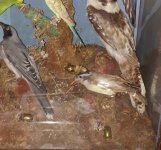H.Clarke1990
Member
Hi All,
I hope that it is ok to post here, but I'm wondering whether someone might be able to help me ID a bird in a historic taxidermy case?
I work for the University of Aberdeen Museums, and am currently trying to update a specimen record for a case of Australian birds. I've managed all except the one on the bottom right of the case, with the yellow crest and white brow bar.
Any suggestions would be much appreciated!
Thanks in Advance,
Hannah
I hope that it is ok to post here, but I'm wondering whether someone might be able to help me ID a bird in a historic taxidermy case?
I work for the University of Aberdeen Museums, and am currently trying to update a specimen record for a case of Australian birds. I've managed all except the one on the bottom right of the case, with the yellow crest and white brow bar.
Any suggestions would be much appreciated!
Thanks in Advance,
Hannah








